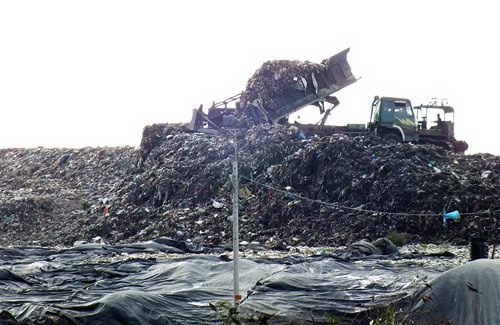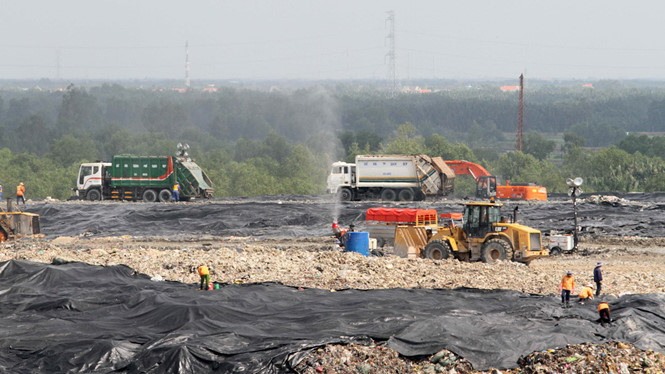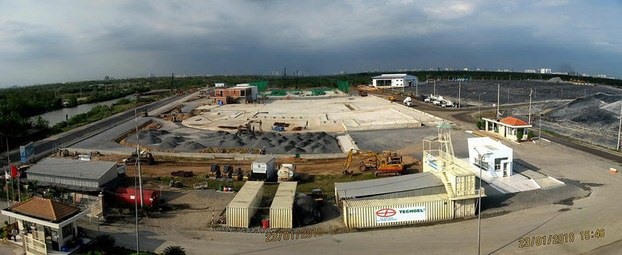 Society
Society

The Đa Phước Waste Treatment Complex has asked municipal authorities to suspend receipt of an additional 2,000 tonnes of garbage per day in response to residents’ complaints about a foul odour coming from the plant.
 |
| The Đa Phước Waste Treatment Complex, which has been receiving and treating more than 5,000 tonnes of waste a day, is the source of a foul odour affecting residents in southern HCM City. Photo Anh Tuấn |
HCM CITY — The Đa Phước Waste Treatment Complex has asked municipal authorities to suspend receipt of an additional 2,000 tonnes of garbage per day in response to residents’ complaints about a foul odour coming from the plant.
The additional rubbish, which has been received since late 2014, will no longer be received beginning next week until the expansion of the wastewater plant at the complex will be completed, slated for February, according to the Việt Nam Waste Solutions (VWS), the investor of the complex.
VWS, which was in charge of designing, building and operating the waste treatment complex at a cost of over US$100 million, sent its request to the city’s Party Committee, People’s Council, People’s Committee and the Department of Natural Resources and Environment.
 |
| The Đa Phước Waste Treatment Complex, which has been receiving and treating more than 5,000 tonnes of waste a day, is the source of a foul odour affecting residents in southern HCM City. — VNS Photo |
In May 2014, VWS began receiving an additional 2,000 tonnes of garbage from the HCM City Urban Environment Company as requested by the city government.
With the additional amount, the complex was treating around 5,400 tonnes of garbage a day.
To accommodate the extra rubbish, VWS has invested in new equipment and hired more workers. They are also expanding the plant, which will have a treatment capacity of 2,000 cubic metres a day when completed.
According to a VWS document sent to the city, the company said it had encountered a number of challenges, including “public prejudice and misunderstanding of the issue, causing hurdles for the complex’s operation, affecting the reputation of the city and the company, especially during the past month.”
The investor said the decision to stop taking additional rubbish was taken in response to public pressure as well as a desire to reduce the volume of storm water mixed with leachate, which rose dramatically after recent downpours.
Beginning next week, if approved by municipal authorities, the company will only receive and treat 3,400 tonnes a day, from 6pm to 6am daily, until the plant expansion is completed.
 |
| The Đa Phước Waste Treatment Complex, which has been receiving and treating more than 5,000 tonnes of waste a day, is the source of a foul odour affecting residents in southern HCM City. — VNS Photo |
On Wednesday, a city official confirmed receipt of the VWS petition, but had no further information.
Nguyễn Toàn Thắng, director of the city’s Department of Natural Resources and Environment, said the city had always signed contracts with relevant parties, including VWS, on waste treatment services.
“The contract will be used to deal with any arising matter,” Thắng said. “Of course, the resolution will be reviewed thoroughly to ensure that environmental protection will be our top priority.”
In late 2014, HCM City closed the Phước Hiệp Waste Treatment Complex in the outlying district of Củ Chi because of pollution.
The 2,000 tonnes of garbage treated by the complex at the time was transferred to the Đa Phước Waste Treatment Complex.
The Hiệp Phước Waste Treatment plant then stopped operation and was converted into a reserve garbage complex.
At the end of August, people living in the southern part of the city, mostly in District 7 and Nhà Bè and Bình Chánh districts, had filed complaints with the city’s Department of Natural Resources and Environment about a foul odour that they said originated from the Đa Phước complex.
On September 29, Võ Văn Hoan, head of the city’s People’s Committee, confirmed that the odour was coming from the Đa Phước complex in Bình Chánh District.
The complex covers an area of hundreds of hectares wide and 25 metres high. The pile of rubbish is expected to reach 40 metres in height soon.
Hoan said the city would soon clear 100 hectares of land to plant trees to reduce the unpleasant odour.
In addition, to improve waste treatment citywide, local authorities said that households and businesses would begin to categorise waste at the source, but they did not specify a date.
The plant’s investor VWS, which provides waste treatment services in Việt Nam, is a subsidiary of California Waste Solutions (CWS) headquartered in California.
 |
| The Đa Phước Waste Treatment Complex, which has been receiving and treating more than 5,000 tonnes of waste a day, is the source of a foul odour affecting residents in southern HCM City. — Photo courtesy of techgel.com |
Đa Phước Complex was built on a soft wet land plot in Đa Phước Commune in Bình Chánh District.
In the first phase of the project, a dumping ground covering an area of 30.6 hectares was set up. It was designed to have a capacity of 10,000 tonnes of waste a day.
Recently, however, more and more doubts about the complex’s capabilities have been raised, especially after the city’s management agencies discovered problems there.
Under the waste treatment contract signed with city authorities, VWS, after receiving solid domestic waste, would classify the waste, recycle it, make compost fertiliser and reuse plastic waste. The rest would be dumped.
HCM City inspectors, however, said earlier this year that VWS had dumped all of its waste it had received and had not treated it properly.
The huge volume of waste carried to Đa Phước over the last 10 years has piled up, creating mountains of garbage. — VNS




